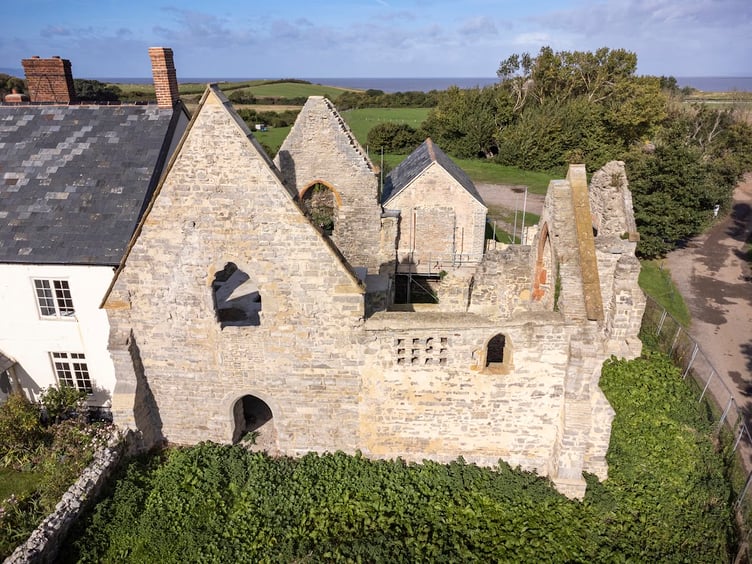TWO historic West Somerset sites have been saved for the nation thanks to the efforts of volunteers and grants from Historic England.
Kilve Chantry and Stowey Castle, both scheduled monuments, have been taken off Historic England’s heritage at risk register.
They were among 80 sites across the Westcountry which were saved and their futures secured in the past year.
A major conservation project to save the picturesque ruin of Kilve Chantry took several years to complete with a large steel structure propping up the south gable wall finally removed last winter.
Stowey Castle, sitting between Nether Stowey and the Quantock Hills, was saved after a dedicated local group cleared it of damaging vegetation.
The ruins of the 14th century Kilve Chantry were placed on Historic England’s Heritage at Risk Register in 2000 due to the poor condition of the masonry and a perilous lean on the south gable wall, which was propped in 2004 to prevent collapse.
Emergency repairs funded by Historic England were completed in 2011, and further phases of work supported by the owner and Historic England were carried out from 2013 onwards and completed in the spring of this year.
The ruins were thought to be those of the chantry of five priests founded in 1329 by Sir Simon de Furneaux to pray for his soul, but more recent research suggests they are the remains of the 13th century manor and main residence of the de Furneaux family.
The buildings had fallen into disrepair before the Dissolution and were re-used as a farm house.
A fire caused severe damage in 1848 and much of the complex has since been ruinous, although the hall range was heightened and divided to become two cottages.
One of the cottages is now a tea room popular with locals and visitors drawn to the area by the South West Coast Path or its literary connections – the landscape inspired William Wordsworth and Samuel Taylor Coleridge’s masterpiece The Lyrical Ballads.
Wordsworth must have known the ruins, as he mentioned ‘Kilve’s delightful shore’ in his poem ‘Anecdote for Fathers’.
A spokesman for the trustees of the East Quantoxhead Estate said: “We are delighted that the repair of the spectacular chantry is now complete.
“Without the financial and technical help of Historic England and a contribution from the Historic Houses Foundation, this conservation project would not have been possible.
“It is clever work by Simon Cartlidge, our architect, and Mann Williams, our structural engineers, bringing a fragile and unsafe ruinous building back into public use.
“It has been a long and difficult project, but it now contributes so much to the area and adds to the attraction of Kilve Beach, which, with its cafe, fossils, dramatic geological formations, and oil retort, is such an interesting and popular place to visit.”
Stowey Castle represents the impressive remains of a medieval motte and bailey fortification with spectacular views across the Bristol Channel.
Motte and bailey castles were introduced into Britain by the Normans and consisted of a motte, which was a large mound of earth on which would have stood a defensive keep built from stone or timber, and one or more baileys, which were enclosed areas overlooked by the keep and usually surrounded by an earthen rampart and timber palisade.
Not only are motte and baileys particularly important to the story of Norman Britain, they add character and distinctiveness to a place, and can be an important community resources, often bringing a wide range of benefits to the physical, mental, and social wellbeing of individuals and communities.
Known locally as ‘The Mount’, Stowey Castle was added to the Heritage at Risk Register in 2018 due to invasive bracken and gorse which had almost completely taken over the whole site.
Bracken and scrub growth can not only cause harm to sensitive archaeological deposits, but also obscure features from view, making places difficult to see and understand as historic monuments.
Together with help from landowner Sue Aubrey, the Quantocks Landscape Partnership Scheme, the Stowey Green Spaces volunteers, and funding from Historic England, the bracken and gorse has been cleared, and the site has been re-fenced to allow a flock of Herdwick sheep to graze the site.
The condition of the castle has been improved, and it is now cared for by the local community and the Stowey Green Spaces Group, allowing it to be removed from the 2022 Heritage at Risk Register.
Ms Aubrey said: “I had struggled over the years to control the spread of bracken and gorse.
“As a member of Stowey Green Spaces Group I suggested The Mount might be a worthwhile project.
“Group members, familiar with The Mount as a popular walk and a place where children sledged over the years were in full agreement.”
Stowey Green Spaces Group chairman Roy Osborn commented: “Clearing the bracken and gorse gave a greater appreciation of the sheer steepness of the motte and the difficulty those attacking would have had in even approaching the bailey.
“This led in turn to a better understanding of the importance of the castle to the village for defence and control in Norman times, and giving the village its identity today.”
Dan Broadbent, historic heritage officer at the Quantock Landscape Partnership Scheme, said: “We are delighted to have been able to support the conservation work at Stowey Castle.
“The provision of new stock-proof fencing has enabled grazing of the motte and bailey site, which, together with the sterling work of volunteers from Stowey Green Spaces, will help to keep the site in good condition for future generations.”
Historic England regional director Rebecca Barrett said: “It is central to Historic England’s mission that we pass on to future generations the rich legacy of historic buildings and places that we have inherited from previous generations.
“Our Heritage at Risk programme is a key contributor to this ambition.
“With the help of local communities and partners, imaginative thinking, and business planning, we can bring historic places back to life in the South West.”





Comments
This article has no comments yet. Be the first to leave a comment.